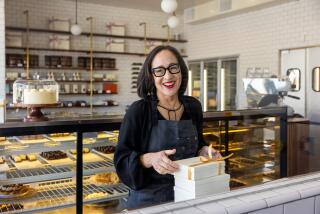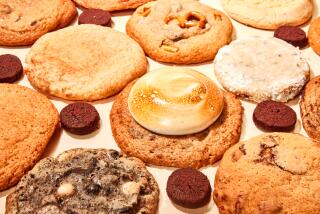Raising the Bar on Chocolate
Swishing the smooth, dark blend around in his mouth, Gary Guittard searches for the right words. âAstringent,â he decides, âwith some floral notes.â
Zinfandel? Or maybe Merlot?
No, chocolate. Itâs a semisweet made from Ecuadorean cocoa beans, just one of the new âvarietalâ and âestateâ chocolates hitting the market.
Designed to attract would-be connoisseurs, these high-end chocolate bars are made from different varieties of cocoa beans grown on plantations around the world, from Venezuela to Trinidad to Madagascar.
Just as different varieties of grapes bring their flavors to wine, Guittard and other chocolatiers insist, the type and terroir of certain cocoa beans bring subtle but distinct flavors to the chocolate they produce.
Venezuelan beans are spicy and nutty. Ecuadoreans have the floral aroma of the rain forest.
Chocolate lovers, theyâre betting, like wine lovers, will be willing to shell out more for a little taste of what they believe to be the finest the world has to offer. Like $3 to $7 for a 3-to-4-ounce bar.
âIf people hear something is the strongest in the world, they want to taste it and say they like it,â says Guittard, president of Guittard Chocolate Co. in Burlingame, Calif. Right or wrong, he says, âitâs got snob appeal.â
Some believe these so-called origin bars and the flowery language used to describe them is just marketing hype, a ploy to make people spend more money on chocolate at a time when consumption appears ready to level off in the U.S.
But if these cocoa pioneers have their way, the labels on chocolate bars soon could be as crowded as wine labels--with descriptions of special blends of beans, information about where the beans are grown, cocoa percentages and, in some cases, even vintages so people can nibble on a âgood year.â Chocolate shops could more closely resemble Starbucks, with people choosing the blend of their beans as well as the fillings.
And more Americans would choose chocolate to fit their mood rather than simply look for âsomething sweet.â
Thatâs still a long shot. Today, varietal chocolate is still very much in its infancy, catching the fancy mainly of pastry chefs and foodies looking for something new and exciting.
But growing sales of these bars at gourmet shops such as Dean & DeLuca, at supermarkets such as Andronicoâs and Bristol Farms and online could be an indication that American tastes are changing.
âWeâve seen a big increase in gourmet or specialty chocolates . . . particularly in the dark, semisweet and 70% cocoa stuff, versus the American milk chocolate,â says Kevin Davis, president of Bristol Farms. âPeople are fine-tuning their taste for chocolate.â
No one knows exactly how sales are progressing because most of the premium chocolate makers and confectioners are private companies that donât release sales figures.
But there is plenty of anecdotal evidence that darker, not-so-sweet chocolate is making inroads on Americaâs beloved milk chocolate. Thatâs similar to how more complex, varietal wines began moving in on sweet carafe wine in the U.S. in the 1980s.
Consumers âhave experienced better olive oil, coffee and wine in recent years,â says Pierrick Chouard, who heads Vintage Chocolates, an Elizabeth, N.J.-based importer of Michel Cluizel varietal chocolates from France. âMaybe they are finding out that the flavor of the food is not linked to a [manufacturer] in Switzerland but to the place that it is grown.â
Reviews in Wine Spectator and other publications describe these chocolates in the same rhapsodic terms they would a California Cabernet or a French Bordeaux. Venezuelan chocolate is âsilky and smooth with hints of black and red fruits,â says Wine Spectator reviewer Sam Gugino. Sumatran-bean chocolate, he says, has a ânice balance of cream, earth and fruit, though it finishes a bit short.â
Executives at specialty chocolate enterprises naturally encourage these wine-like comparisons.
âWe are trying to be the Chateau Mouton Rothschild of chocolate,â says Bernard DeClos, who imports varietal chocolate from French manufacturer Valrhona.
As far as big companies go, only Godiva, the large chocolate company owned by Campbell Soup Co., appears to be considering a line of varietal chocolates in the U.S. Hershey Foods Corp. and Nestle, the two giants in American chocolate, are sticking to the proven mass market.
Godiva officials say they are weighing whether to take a chance on pure dark bars or to fill them with something sweet, such as a ganache or praline cream.
âWe are trying to understand the role of origins,â says Michael Simon, Godiva Chocolatierâs vice president of marketing. âWe want products that have a wide breadth of appeal for our consumers.â
At the same time, consumers have begun demanding a broader range of chocolate to choose from, whether itâs more levels of bittersweet chocolate or a new âdark milkâ chocolate.
âItâs no longer acceptable to just say dark chocolate, milk chocolate or semisweet,â says Michael Schneider, editor in chief of Chocolatier magazine. âItâs just not specific enough.â
Americansâ chocolate consumption has been climbing over the last two decades, as chocolate has found its way into more foods. It rose from 8 pounds per person each year in 1983 to 12 pounds today. Thatâs still well below the 22 pounds that the Swiss eat each year. However, some believe that U.S. chocolate consumption is close to leveling off, having almost fully penetrated the vast American market for snack foods.
What Americans are eating is a little more expensive than it has been in years past, says food marketing consultant Joan Steuer. Given the rising sales of companies such as Godiva, she believes that consumers are indulging in small bits of finer chocolate more often.
Steuer calls it the âclass-going-massâ phenomenon. As gourmet items such as Ghirardelli chocolate have found their way into supermarkets and drugstores, peopleâs expectations have been raised.
âItâs the same trend that has been going on with artisan cheese, breads and microbreweries,â she says. âThereâs a desire to look at the origins of things and how they are made.â
There are two main types of specialty chocolate: blends and single-origin, or estate, chocolate. Blends use cocoa beans of different locales to achieve different flavors.
Guittardâs new E. Guittard Founderâs Reserve line includes blends made from cocoa beans grown on select estates in Ecuador, Colombia and Venezuela, including his special LâHarmonie blend from a proprietary mix of estate-grown beans. The beans from these regions are purported to have stronger flavors than the mild African beans used in most candy bars. African beans are used in small amounts to create these blends.
Single-origin bars are for the chocolate purist. They are made from beans from a single source, much like estate-bottled wine.
Valrhonaâs $6 Gran Couva bar, for instance, is made from beans grown on one company-owned plantation in Trinidad, where it controls production from start to finish.
Michel Cluizel has a line of both single-origin Gran Cru chocolates and varietal blends designed to leave chocolate lovers with several layers of flavor in their mouths.
Pastry chefs and confectioners argue constantly about which is better, single-origin chocolates or blends, just as winemakers argue the pros and cons of estate wine.
Even more important, Guittard says, is how the beans are handled once they are taken from the pods of the cacao tree. If they are dried too fast after harvesting or dried by fire, they can develop off or smoky tastes. If they arenât fermented long enough, the beans remain bitter and donât develop a strong chocolate flavor.
The roast is important too. A dark roast can turn bitter even the most mellow bean.
Chocolate is made by roasting cocoa beans, removing the shells and then crushing and heating the ânib,â or meat of the bean, until it forms a thick paste called chocolate liquor.
The liquor is combined with cocoa butter, sugar, milk and vanilla. It is mixed and then âconched,â or stirred under heat for a few hours to a few days to reduce undesirable odors and reduce the size of the particles.
Itâs then poured into molds for bars or wafers.
The best chocolate, Schneider says, is the chocolate with the most cocoa butter.
This gives it that melt-in-your-mouth quality that lingers after the chocolate is gone. Big chocolate manufacturers such as Mars Inc., Nestle and Hershey usually use a smaller percentage of cocoa and less cocoa butter, more sugar or sometimes sorbitol (a sweetener) to give their products a longer shelf life.
Chocolate doesnât have to be expensive to be good. Strict government standards for chocolate in the U.S. keep unwanted fillers and oils out of most candy.
âI eat M&Ms;, and I donât care who knows it,â Schneider says.
But when he wants something decadent or different, he says, he turns to premium artisan chocolate.
Confectioners and pastry chefs at fine restaurants are buying most of the darker varietal chocolate and giving people their first taste. Restaurants are peddling Valrhona chocolate cake, Scharffen Berger chocolate ice cream and Guittard enrobed caramels for dessert.
Gourmet specialty stores such as Williams-Sonoma and Dean & DeLuca also are beginning to stock it, as are Whole Foods and other high-end supermarkets.
However, just because these varietal chocolates are gaining acceptance doesnât mean consumers will be willing to pay a big premium for them, as they do for fine wine.
Chocolate, after all, doesnât provide the same buzz that wine gives those who drink it.
Itâs a more fleeting pleasure. Chocolate, unlike a good Burgundy, doesnât mature and evolve over time. âNobody is opening 95-year-old boxes of chocolate,â Schneider says. âYou canât. It would be disgusting.â
More to Read
Sign up for The Wild
Weâll help you find the best places to hike, bike and run, as well as the perfect silent spots for meditation and yoga.
You may occasionally receive promotional content from the Los Angeles Times.






